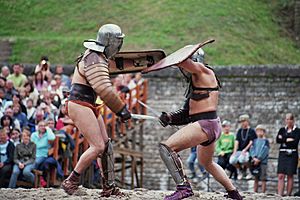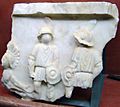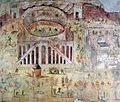Gladiator facts for kids

Gladiators (Latin: gladiatōrēs, "swordsmen" or "one who uses a sword," from gladius, "sword") were professional fighters in ancient Rome, who fought against each other,wild animals , and sentenced criminals, sometimes to the death, for the entertainment of the public. These fights took place in arenas in many cities from the Roman Republic period through the Roman Empire.
The word comes from gladius, the Latin word for a short sword used by legionaries and some gladiators.
There were different types of gladiators in the world, such as Thracians, Mirmillones, Retiarii, and the Secutores.The gladiators were the footballers of their time.You would have been very famous and rich.
The Emperor would have the final say about who would live and who would die. He would put his thumbs up to die or thumbs down to live.
Images for kids
-
Part of the Zliten mosaic from Libya (Leptis Magna), about 2nd century AD. It shows (left to right) a thraex fighting a murmillo, a hoplomachus standing with another murmillo (who is signaling his defeat to the referee), and one of a matched pair.
-
Relief of gladiators from Amphitheatre of Mérida, Spain
-
Musicians with trumpet (tuba), water organ (hydraulis), and horns (cornua), from the Nennig gladiator mosaic
-
Gladiators after the fight, José Moreno Carbonero (1882)
-
Mérida amphitheatre, Spain; mural of beast hunt, showing a venator (or bestiarius) and lioness
-
Late 3rd century gladiator mosaic from a private residence in Kourion, Cyprus. All the participants are named. The central figure (Darios) is positioned as a referee but wears a citizen's high-status toga or tunic with broad stripes
-
Murmillo gladiator helmet with relief depicting scenes from the Trojan War; from Herculaneum
-
Gladiator helmet found in Pompeii, with scenes from Greek Mythology
-
Shin guard depicting Venus Euploia (Venus of the "fair voyage") on a ship shaped like a dolphin
-
Nimes, 2005.
See also
 In Spanish: Gladiador para niños
In Spanish: Gladiador para niños

























